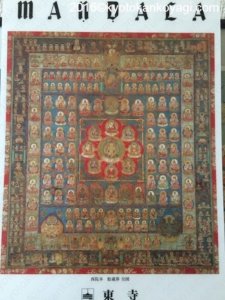What is Goshichinichi Mishiho? 後七日御修法とは?
Goshitiniti Mishiho is held at Kanjoin (灌頂院) temple, the sub-temple of Toji temple, for a week.
The history of Misho dates back to 835. Kukai (空海), the who introduced Vajrayana Buddhism from Tan dynasty of ancient China to Japan, held the first Mishio for the purpose of “Gyokutai Antai (玉体安穏).” The word literary means “The safety and prosperity of the Emperor.” At that time, the Emperor was equivalent to Japan because he was the highest ranked Shinto priest and responsible for the country. In Shingonin hall in the Imperial place, as celebrating a new year, Mishiho took place in 2 ways: The Shinto (From Jan. 1 to 7) and Buddhist rituals (From Jan. 8 to 14).
The latter part was called “Kyochu Shingonin Goshichinichi Mishiho(宮中真言院後七日御修法) and still takes place in Toji temple.
Though Goshichinichi Mishiho has over 1100 years of history, it nearly failed the test of time. In 1461, it faced first difficulty: The civil war. It was suspended by 1622. The second one is “Hiabutsukisyaku.” Buddhism was introduced to Japan in the 6th century. Since then, it had been co-existed and fused with Shinto, the religion indigenous to Japan.The Meiji government separated them in terms of law in 1868. Due to the separation, people ousted Buddhism and Goshichinichi Mishiho was suspended in 1871 again. In 1883, it restored as a ritual held in Kanjoin of Toji temple.
What is going on in Goshichinichi Mishiho? なにをするのか
Mishiho is a supreme ritual in ajrayana Buddhism. From 8th to 14th January, high-ranked monks visit Kanjoin temple three times a day to pray for the prosperity of our country, world peace, and good harvest of the year. On 11th and 14th, Chokushi, a messenger of the Emperor pay a visit to Kanjoin on behalf of him. (The grey-haired man in morning coat is Chokushi.) And on 12nd, a special ritual held in front of “Niken Kannnon,” a statue of Kannon belonged to the Emperor.
Kanjoin temple is divided to the south and north part by a corridor. Goshichinichi Mishiho is held in the north part called “Seido.”
Inside Seido, there are 2 Mandala hanging on the wall. Mandala is a picture teaches people Buddhist teaching. In front of one of them, the most Important Mishiho is held use Mandala as Gohonzon, a object to pray. Every other year, Goshichinichi Mishihois held in Saiin way and Kajuji way. The Mandala used as Gohonzon depends on these ways. There are many kind rituals held and “Onzo(御衣)”, a special garment for the Emperor is plays an important role in one of them. In the ritual, monks ask Buddhist Deities to give an extraordinary power to save the Emperor to the garment. These Deities protect the Emperor on the outfit and the country he represents.These rituals are not open to public because “Gohosan(御宝算)” appears in a ritual. On Gohosan, the birthday and name of the Emperor is written. In ancient times, people believed that they can curse a person to cease to exist with their birthday and name.
Fortunately, we can visit Kanjoin temple for only an hour after Goshichinichi Mishiho was finished on 14th January.

It sounds weird but ancient people believed the curse in that way.

For example, we can see an example in Okeage Myojin in Jishu shrine.
Ato Ogami 後拝みと灌頂院の参拝方法
As described in the last chapter, we can visit Kanjoin after the Goshichinichi Mishiho. The visit is called “Ato Ogami.” Ato Ogami visit is available only for 1 hour. Actually, Kanji in is open to us for 7 hours a year. The other occasion is on 21st April.
The gate of Kanjinin temple opens around 12:30. (We can tell exact time because the time depends on the rituals.) People wait in line in front of the gate.
This is the gate. It is a gate only for Chokushi but we can enter it. After the gate, pay 1,000 yen.
And a monk gives us this amulet. With this, Niken Kannnon saves us.
Now we enter Kanjoin. Take off your shoes at the entrance. Monks give you a plastic bag to put the shoes in.

Slippers or over-socks will do!
Taking pictures is banned inside. There only are candle lantern there. Watch out your steps. We walk around Seido in clock-wise and exit Kanjoin.
Outside of Kanjoin, we’ll find this. It is called “Jingudan(神供壇),” a kind of altar for Deities.
Then, we head for the north gate, the exit of Kanjoin. We find this on the way. It was a well called “Akai.” The water of the well would be used in important rituals. Under the roof, there are three pieces of wood on which a red horses painted. It is said that they told fortune to farmers.
After the Akai, we head for the north gate. 合掌。
東寺基本情報
Access to Toji 東寺へのアクセス
Kyoto city bus: Toji Higashimon mae, or Toji michi bus stop.
JR East: JR Kyoto station
Kintetsu railways: Toji station
ヤギの京都観光案内/KYOTO GOAT BLOGをもっと見る
購読すると最新の投稿がメールで送信されます。












